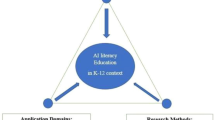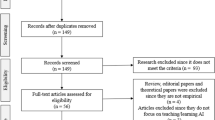Abstract
Scientific literacy is considered a crucial part of learners’ basic capacities. In primary schools, scientific literacy is generally cultivated through the implementation of a natural science curriculum, in which botany is an essential course. To enhance learning effectiveness, learning activities that involve observing specific plants and carried out in outdoor learning environments have been widely adopted in instructional design. Augmented reality (AR) technology can provide views of the real-world environment simulated by a computer in connection with a target learning object. Hence, AR-based learning material was employed in this study to provide multifaceted views of plants being studied, thereby enhancing the learning experience. To validate the effectiveness of this approach, 54 third-grade students were recruited as participants in a plant observation activity that involved various learning materials. Their learning outcomes when using AR were measured according to Bloom’s cognitive levels, showing the degree of learning achievement for different stages. According to the results, students in the experimental group observing the plants through AR had significantly greater comprehension compared with those in the control group, with respect to conceptual analysis and identification of leaf arrangement. The findings suggest that compared with the traditional learning approach involving plant observation, AR-based learning material could significantly enhance students’ higher-level cognitive capabilities, enabling them to more effectively scaffold knowledge about target plants in the observational learning activity.






Similar content being viewed by others
References
DeBoer, G.E.: Scientific literacy: another look at its historical and contemporary meanings and its relationship to science education reform. J. Res. Sci. Teach. 37, 582–601 (2000)
He, J., Van De Vijver, F.J.: Effects of a general response style on cross-cultural comparisons evidence from the teaching and learning international survey. Public Opin. Q. 79, 267–290 (2015)
Fensham, P.: Programme for international student assessment (PISA). Encycl. Sci. Educ. 799–801 (2015)
Schussler, E.E.: From flowers to fruits: how children’s books represent plant reproduction. Int. J. Sci. Educ. 30, 1677–1696 (2008)
OBE, W.H., Qualter, A.: The Teaching of Science in Primary Schools. David Fulton Publishers, London (2014)
Wang, S.L., Chen, C.C., Zhang, Z.G.: A context-aware knowledge map to support ubiquitous learning activities for a u-Botanical museum. Aust. J. Educ. Technol. 31, 470–485 (2015)
Gerber, B.L., Cavallo, A.M., Marek, E.A.: Relationships among informal learning environments, teaching procedures and scientific reasoning ability. Int J. Sci Educ. 23, 535–549 (2001)
Law, K.M., Lee, V.C., Yu, Y.T.: Learning motivation in e-learning facilitated computer programming courses. Comput. Educ. 55, 218–228 (2010)
Sung, H.Y., Hwang, G.J.: A collaborative game-based learning approach to improving students’ learning performance in science courses. Comput. Educ. 63, 43–51 (2013)
Sharples, M., Taylor, J., Vavoula, G.: A theory of learning for the mobile age. In: Medienbildung in neuen Kulturräumen, pp. 87–99. Springer, Berlin (2010)
Huang, Y.M., Lin, Y.T., Cheng, S.C.: Effectiveness of a mobile plant learning system in a science curriculum in Taiwanese elementary education. Comput. Educ. 54, 47–58 (2010)
Lai, C.H., Yang, J.C., Chen, F.C., Ho, C.W., Chan, T.W.: Affordances of mobile technologies for experiential learning: the interplay of technology and pedagogical practices. J. Comput. Assist. Lear. 23, 326–337 (2007)
Sommerauer, P., Müller, O.: Augmented reality in informal learning environments: a field experiment in a mathematics exhibition. Comput. Educ. 79, 59–68 (2014)
Çepni, S., Taş, E., Köse, S.: The effects of computer-assisted material on students’ cognitive levels, misconceptions and attitudes towards science. Comput. Educ. 46, 192–205 (2006)
Mikkilä-Erdmann, M.: Improving conceptual change concerning photosynthesis through text design. Learn. Instr. 11, 241–257 (2001)
Tas, E., Cepni, S., Kaya, E.: The effects of web-supported and classical concept maps on students’ cognitive development and misconception change: a case study on photosynthesis. Energy Educ. Sci. Technol. Part B 4, 241–252 (2012)
Anderson, L., Krathwohl, R., Airasian, P., Cruikshank, K., Mayer, R., Pintrich, P., Raths, J., Wittrock, M.: A Taxonomy for Learning, Teaching, and Assessing: A Revision of Bloom’s Taxonomy of Educational Objectives. Longman, New York, NY (2001)
Dunleavy, M., Dede, C., Mitchell, R.: Affordances and limitations of immersive participatory augmented reality simulations for teaching and learning. J. Sci. Educ. Technol. 18, 7–22 (2009)
Klopfer, E., Sheldon, J.: Augmenting your own reality: student authoring of science-based augmented reality games. New Directions Youth Dev. 128, 85–94 (2010)
Wojciechowski, R., Cellary, W.: Evaluation of learners’ attitude toward learning in ARIES augmented reality environments. Comput. Educ. 68, 570–585 (2013)
Van Krevelen, D., Poelman, R.: A survey of augmented reality technologies, applications and limitations. Int. J. Virtual Real. 9, 1 (2010)
Azuma, R.T.: A survey of augmented reality. Presence: Teleoper. Virtual Environ. 6, 355–385 (1997)
Yuen, S., Yaoyuneyong, G., Johnson, E.: Augmented reality: an overview and five directions for AR in education. J. Educ. Technol. Dev. Exch. 4, 119–140 (2011)
Shelton, B.E., Hedley, N.R.: Exploring a cognitive basis for learning spatial relationships with augmented reality. Technol. Instr. Cognit. Learn. 1, 323–357 (2004)
Kaufmann, H., Steinbügl, K., Dünser, A., Glück, J.: General training of spatial abilities by geometry education in augmented reality. Ann. Rev. CyberTherapy Telemed.: A Decade of VR 3, 65–76 (2005)
Di Serio, Á., Ibáñez, M.B., Kloos, C.D.: Impact of an augmented reality system on students’ motivation for a visual art course. Comput. Educ. 68, 586–596 (2013)
Huang, T.C., Chen, C.C., Chou, Y.W.: Animating eco-education: to see, feel, and discover in an augmented reality-based experiential learning environment. Comput. Educ. 96, 72–82 (2016)
Arvanitis, T.N., Petrou, A., Knight, J.F., Savas, S., Sotiriou, S., Gargalakos, M., Gialouri, E.: Human factors and qualitative pedagogical evaluation of a mobile augmented reality system for science education used by learners with physical disabilities. Pers. Ubiquit. Comput. 13, 243–250 (2009)
Klopfer, E., Squire, K.: Environmental Detectives—the development of an augmented reality platform for environmental simulations. ETR&D-EDUC Technol. Res. 56, 203–228 (2008)
Squire, K., Klopfer, E.: Augmented reality simulations on handheld computers. J. Learn. Sci. 16, 371–413 (2007)
Kaufmann, H., Schmalstieg, D.: Mathematics and geometry education with collaborative augmented reality. Comput. Graph. 27, 339–345 (2003)
Kamarainen, A.M., Metcalf, S., Grotzer, T., Browne, A., Mazzuca, D., Tutwiler, M.S., Dede, C.: EcoMOBILE: integrating augmented reality and probeware with environmental education field trips. Comput. Educ. 68, 545–556 (2013)
Hwang, W.Y., Shadiev, R.: Cognitive diffusion model with user-oriented context-to- text recognition for learning to promote high level cognitive processes. Knowl. Manag. E-Learn. 6, 30–48 (2014)
Kolb, D.A.: Experiential Learning: Experience as the Source of Learning and Development. Prentice-Hall, Englewood Cliffs, NJ (1984)
Young, M.R.: Experiential learning = hands-on + minds-on. Mark. Educ. Rev. 12, 43–51 (2002)
Chaillé, C., Britain, L.: The Young Child as Scientist: A Constructivist Approach to Early Childhood Science Education. Allyn and Bacon, Boston, MA (2003)
Roussou, M.: Learning by doing and learning through play: an exploration of interactivity in virtual environments for children. Comput. Entertain. 2, 10 (2004)
Dunlap, J., Dobrovolny, J., Young, D.: Preparing e-learning designers using Kolb’s model of experiential learning. Innov. J. Online Educ. 4, 1–6 (2008)
Bloom, B.S.: Taxonomy of Educational Objectives: Handbook I: Cognitive Domain. Longman, New York (1956)
Hwang, W.Y., Wang, C.Y., Hwang, G.J., Huang, Y.M., Huang, S.: A web-based programming learning environment to support cognitive development. Interact. Comput. 20, 524–534 (2008)
Shadiev, R., Hwang, W.Y., Huang, Y.M., Liu, T.Y.: Cognitive diffusion model: facilitating EFL learning in an authentic environment. IEEE Trans. Learn. Technol. 10, 168–181 (2017)
Krathwohl, D.R.: A revision of Bloom’s taxonomy: an overview. Theor. Pract. 41, 212–218 (2002)
StatSoft I: Electronic Statistics Textbook. http://www.statsoft.com/textbook/ (2011). Accessed August 2 2011
Wu, H.K., Lee, S.W.Y., Chang, H.Y., Liang, J.C.: Current status, opportunities and challenges of augmented reality in education. Comput. Educ. 62, 41–49 (2013)
Wood, D., Bruner, J.S., Ross, G.: The role of tutoring in problem solving. J. Child Psychol. Psyc 17, 89–100 (1976)
Hornecker, E., Dünser, A.: Of pages and paddles: children’s expectations and mistaken interactions with physical–digital tools. Interact. Comput. 21, 95–107 (2009)
Martín-Gutiérrez, J., Contero, M., Alcañiz, M.: Evaluating the usability of an augmented reality based educational application. In: International Conference on Intelligent Tutoring Systems, pp 296–306. Springer, Berlin (2010)
Acknowledgements
This research is partially supported by the Ministry of Science and Technology, Taiwan, R.O.C. under Contracts Nos. MOST 105-2622-S-006-001-CC2, MOST 103-2511-S-006-007-MY3, MOST 103-2511-S-006-002-MY3, MOST 104-2511-S-224-003 -MY3, and MOST 105-2628-S-224 -001 -MY3.
Author information
Authors and Affiliations
Corresponding author
Rights and permissions
About this article
Cite this article
Chien, YC., Su, YN., Wu, TT. et al. Enhancing students’ botanical learning by using augmented reality. Univ Access Inf Soc 18, 231–241 (2019). https://doi.org/10.1007/s10209-017-0590-4
Published:
Issue Date:
DOI: https://doi.org/10.1007/s10209-017-0590-4




